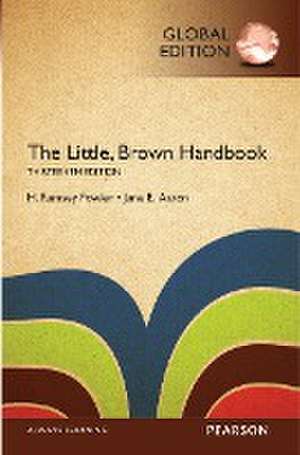The Little, Brown Handbook, Global Edition
Autor Jane E. Aaron, H. Ramsey Fowleren Limba Engleză Paperback – 18 iun 2015
MyWritingLabGäó not included. Students, if MyWritingLab is a recommended/mandatory component of the course, please ask your instructor for the correct ISBN and course ID. MyWritingLab should only be purchased when required by an instructor. Instructors, contact your Pearson representative for more information.
MyWritingLab is an online homework, tutorial, and assessment product designed to personalize learning and improve results. With a wide range of interactive, engaging, and assignable activities, students are encouraged to actively learn and retain tough course concepts.
Preț: 446.15 lei
Preț vechi: 564.74 lei
-21% Nou
Puncte Express: 669
Preț estimativ în valută:
85.38€ • 88.81$ • 70.49£
85.38€ • 88.81$ • 70.49£
Carte disponibilă
Livrare economică 24 martie-07 aprilie
Livrare express 08-14 martie pentru 53.62 lei
Preluare comenzi: 021 569.72.76
Specificații
ISBN-13: 9781292099477
ISBN-10: 129209947X
Pagini: 936
Dimensiuni: 154 x 226 x 39 mm
Greutate: 1.14 kg
Ediția:13th edition
Editura: Pearson
Colecția Pearson Higher Education
ISBN-10: 129209947X
Pagini: 936
Dimensiuni: 154 x 226 x 39 mm
Greutate: 1.14 kg
Ediția:13th edition
Editura: Pearson
Colecția Pearson Higher Education
Cuprins
Preface for Students: Using This Book Preface for Instructors PART 1: The Process of Writing 1. Assessing the Writing Situation a. Understanding how writing happens b. Analyzing the writing situation c. Discovering and limiting a subject d. Defining a purpose e. Considering the audience f. Understanding genres 2. Discovering and Shaping Ideas a. Discovering ideas b. Developing a thesis c. Organizing ideas SAMPLE INFORMATIVE ESSAY 3. Drafting, Revising, and Editing a. Writing the first draft b. Revising a draft c. Giving and receiving comments d. Examining a sample revision e. Editing the revised draft f. Preparing and proofreading the final draft g. SAMPLE FINAL DRAFT (RESPONSE ESSAY) h. Preparing a writing portfolio 4. Writing and Revising Paragraphs a. Relating paragraphs in the essay b. Maintaining paragraph unity c. Achieving paragraph coherence d. Developing the paragraph e. Writing special kinds of paragraphs 5. Presenting Writing a. Formatting academic writing SAMPLE MARKETING REPORT b. Using visuals and other media in multimodal writing c. Presenting writing on the Web SAMPLE WEB SITE SAMPLE LITERACY NARRATIVE POSTED TO A BLOG d. Making oral presentations SAMPLE POWERPOINT SLIDES PART 2: Reading and Writing in and out of College 6. Writing in Academic Situations a. Determining purpose and audience b. Using an academic genre c. Choosing structure and content d. Using sources with integrity e. Using academic language f. Communicating with instructors and classmates 7. Critical Reading and Writing a. Using techniques of critical reading b. Summarizing c. Developing a critical response d. Viewing visuals critically e. Writing critically f. Examining sample critical analyses SAMPLE CRITICAL ANALYSIS OF A TEXT SAMPLE CRITICAL ANALYSIS OF AN IMAGE 8. Reading Arguments Critically a. Recognizing the elements of argument b. Testing claims c. Weighing evidence d. Discovering assumptions e. Watching language, hearing tone f. Judging reasonableness g. Recognizing fallacies h. Reading visual arguments 9. Writing an Argument a. Finding a subject b. Conceiving a thesis statement c. Analyzing your purpose and your audience d. Using reason e. Using evidence f. Reaching your readers g. Organizing your argument h. Revising your argument i. SAMPLE PROPOSAL ARGUMENT 10. Taking Essay Exams a. Preparing for an essay examination b. Planning your time and your answer c. Starting the essay d. Developing the essay e. Rereading the essay 11. Pu
